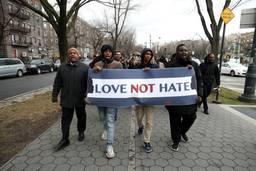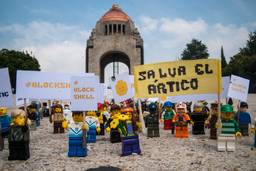
In 1968, the legendary U.S. labor organizer Cesar Chavez went on a 25-day hunger strike. While depriving himself of food, he condemned abusive conditions suffered by farm workers. The slogan of his historic union drive was: “Si se puede!” Yes, we can!
In early May, George Bush went on a four-day bus ride. While stopping for multiple pancake breakfasts, he praised tax cuts and condemned everyone who says American workers need protection in the global economy. His battle cry for laissez-faire economics? “Yes, America can!”
The echo was probably intentional. Bush is so desperate for the Hispanic vote that he has taken to shouting “Vamos a ganar! We’re going to win!” during stump speeches in Ohio.
But the main purpose of the “Yes, American can” bus tour, of course, was to shift the attention of U.S. voters away from the Iraq prison scandal towards the recovering job market. According to a U.S. Labor Department report, 288,000 jobs were created in April. Bush’s campaign has seized on these numbers to further cast John Kerry as the dour New England pessimist, always droning on with bad news. Bush, on the other hand, is the bouncy Texan optimist, always flashing an easy smile and a thumbs-up. “The president has to make sure that we’re optimistic and confident in order for jobs to be created,” he told a crowd in Dubuque, Iowa.
Some jobs, however, are more responsive than others to the power of positive presidential thinking. More than 82 percent of the jobs created in April were in service industries, including restaurants and retail. The biggest new employers were temp agencies. Over the past year, 272,000 manufacturing jobs have been lost. No wonder the president’s economic report in February floated the idea of reclassifying fast-food restaurants as factories. “When a fast-food restaurant sells a hamburger, for example, is it providing a ‘service’ or is it combining inputs to ‘manufacture’ a product?” the report asks.
But not all of the job growth in the United States has come from burger flipping and temping. With more than 2 million Americans behind bars, the number of prison guards has exploded — from 270,317 in 2000 to 476,000 in 2002.
Watching Bush give the thumbs up in the face of so much economic misery put me in mind of a certain widely circulated photograph taken in Iraq. There are Spc. Charles Graner and Pvt. Lynndie England, the happy couple, standing above a pile of tortured Iraqi inmates, grinning and giving the double thumbs up. Everything is fine, their eyes seem to be saying, just don’t look down.
There’s something else connecting the sorry state of the U.S. job market and the images coming out of Abu Ghraib. The young soldiers taking the fall for the prison abuse scandal are the McWorkers, prison guards and laid-off factory workers of Bush’s so-called economic recovery. The résumés of the soldiers facing abuse charges come straight out of the April Labor Department report.
There’s Spc. Sabrina Harman, of Lorton, Virginia, assistant manager of her local Papa John’s Pizza. There’s Spc. Graner, a prison guard back home in Pennsylvania. There’s Sgt. Ivan Frederick, another prison guard, this time from rural Virginia.
Before he joined what Van Jones, a prisoners’ rights lawyer, calls “America’s gulag economy,” Frederick had a decent job at the Bausch and Lomb factory in Mountain Lake, Maryland. But according to the New York Times, that factory shut down and moved to Mexico — one of the nearly 900,000 jobs that the Economic Policy Institute estimates have been lost since the North American Free Trade Agreement came into force in 1994, the vast majority in manufacturing.
Free trade has turned the U.S. labor market into an hourglass: plenty of jobs at the bottom, a fair bit at the top, but very little in the middle. At the same time, getting from the bottom to the top has become increasingly difficult, with tuition fees at state colleges up by more than 50 percent since 1990.
And that’s where the U.S. military comes in: The Army has positioned itself as the bridge across America’s growing class chasm: money for tuition in exchange for military service. Call it the NAFTA draft.
It worked for England, the most infamous of the Abu Ghraib accused. She joined the military police to pay for college. Her colleague Sabrina Harman joined up for the same reason.
Of course, the poverty of the soldiers involved in prison torture makes them neither more guilty nor less. But the more we learn about them, the clearer it becomes that the lack of good jobs and social equality in the United States is precisely what brought them to Iraq in the first place. Despite his attempts to use the economy to distract attention from Iraq, and his efforts to isolate the soldiers as un-American deviants, these are the children George Bush left behind, fleeing dead-end McJobs, abusive prisons, unaffordable education and closed factories.
And they are his children in another way too: It’s in the ubiquitous thumbs-up sign they flash, seemingly oblivious to the disaster at their feet. This is the quintessential George Bush pose. Convinced that U.S. voters want a positive president, the Bush team has learned to use optimism as an offensive weapon: No matter how devastating the crisis, no matter how many lives have been destroyed, they have insistently given the world the thumbs up.
Donald Rumsfeld? “Doing a superb job,” according to the optimist-in-chief. The mission in Iraq? “We’re making progress, you bet,” Bush told reporters one year after his disastrous “mission accomplished” speech. And the U.S. job market, which has driven so many into poverty? “Yes, America can!”
We don’t yet know who taught these young soldiers how to torture their prisoners. But we do know who taught them how to stay happy-go-lucky in the face of tremendous suffering. That lesson came straight from the top.
Naomi Klein is a former columnist for In These Times. She is the author of No Logo: Taking Aim at the Brand Bullies, Fences and Windows: Dispatches from the Front Lines of the Globalization Debate and The Shock Doctrine: The Rise of Disaster Capitalism.









